Optimized Water and Fertilizer Management of Mature Jujube in Xinjiang Arid Area Using Drip Irrigation
Abstract
:1. Introduction
2. Materials and Methods
2.1. Experimental Site
2.2. Field Experiment Layout
2.3. Experiment Design
2.4. Measurements and Methods Applied
2.4.1. Crop Growth
2.4.2. Photosynthetic Characteristics
2.4.3. Chlorophyll and Nitrogen Contents
2.4.4. Water and Fertilizer Efficiency and Crop Yield
2.4.5. Water and Fertilizer Optimization Method
3. Results and Analysis
3.1. Effects of Water–Fertilizer Treatments on the Physiological Indicators
3.2. Effects of Water–Fertilizer Treatments on the Growth Indexes and Crop Yield
3.3. Optimized Water and Fertilizer Managements of Jujube in the Xinjiang Area
4. Discussion
5. Conclusions
Author Contributions
Acknowledgments
Conflicts of Interest
Abbreviations
References
- Sun, S.M.; Yang, P.L.; An, Q.X.; Xu, R.; Yao, B.L.; Li, F.Y.; Zhang, X.X. Investigation into surface and subsurface drip irrigation for jujube trees grown in saline soil under extremely arid climate. Eur. J. Hortic. Sci. 2016, 81, 165–174. [Google Scholar] [CrossRef]
- Liu, G.H.; Wei, Y.Q.; Wang, Z.Y.; Xie, X.W. Water and fertilizer management of jujube in arid area of Xinjiang province using microirrigation system. Bull. Agric. Sci. Technol. 2015, 5, 307–309. [Google Scholar]
- Nelson, S.D.; Young, M.; Enciso, J.M.; Klose, S.L.; Sétamou, M. Impact of irrigation method on water savings and ‘rio red’ grapefruit pack-out in south texas. Subtropical Plant Sci. 2011, 63, 14–22. [Google Scholar]
- Wang, F.X.; Kang, Y.; Liu, S.P. Effects of drip irrigation frequency on soil wetting pattern and potato growth in north china plain. Agric. Water Manag. 2006, 79, 248–264. [Google Scholar] [CrossRef]
- Lafarge, T.A.; Hammer, G.L. Predicting plant leaf area production: Shoot assimilate accumulation and partitioning, and leaf area ratio, are stable for a wide range of sorghum population densities. Field Crop Res. 2002, 77, 137–151. [Google Scholar] [CrossRef]
- Hammad, H.M.; Ahmad, A.; Abbas, F.; Farhad, W.; Cordoba, B.C.; Hoogenboom, G. Water and nitrogen productivity of maize under semiarid environments. Crop Sci. 2015, 55, 877–888. [Google Scholar] [CrossRef]
- Man, J.; Yu, Z.; Zhang, Y.; Shi, Y.; Wang, L. Water and nitrogen use of winter wheat under different supplemental irrigation regimes. Crop Sci. 2016, 56, 3237–3249. [Google Scholar] [CrossRef]
- Ma, D.Y.; Zhang, J.; Hou, J.F.; Li, Y.G.; Huang, X.; Wang, C.Y.; Lu, H.F.; Zhu, Y.J.; Guo, T.C. Evaluation of yield, processing quality, and nutritional quality in different-colored wheat grains under nitrogen and phosphorus fertilizer application. Crop Sci. 2017, 58, 402–415. [Google Scholar] [CrossRef]
- Albrizio, R.; Todorovic, M.; Matic, T.; Stellacci, A.M. Comparing the interactive effects of water and nitrogen on durum wheat and barley grown in a mediterranean environment. Field Crop Res. 2010, 115, 179–190. [Google Scholar] [CrossRef]
- Yang, R.; Su, Y.Z. Responses of net photosynthetic rate in flowering and boll-forming stages, and cotton yield to irrigation and nitrogen fertilizer application. Plant Nutr. Fert. Sci. 2011, 17, 404–410, (In Chinese with English abstract). [Google Scholar]
- Wang, J.X.; Zhang, X.P.; Gao, B.S. Accelerating function of fertilizer and irrigation on shoot growth and flowering of young dwarfing apple tree. Agric. Res. Arid Areas 2004, 22, 47–50, (In Chinese with English abstract). [Google Scholar]
- Wang, Z.H.; Quan, L.S.; He, J.B. Effect of water and fertilizer coupling on water consumption and yield of drip irrigation grape in extreme arid region. Water Saving Irrig. 2014, 6, 634–637, (In Chinese with English abstract). [Google Scholar]
- Feng, Y.; Cui, N.B.; Du, T.S.; Gong, D.Z.; Hu, X.T.; Zhao, L. Response of sap flux and evapotranspiration to deficit irrigation of greenhouse pear-jujube trees in semi-arid northwest china. Agric. Water Manag. 2017, 194, 1–12. [Google Scholar] [CrossRef]
- Cui, N.B.; Du, T.S.; Li, F.S.; Tong, L.; Kang, S.Z.; Wang, M.X.; Liu, X.Z.; Li, Z.J. Response of vegetative growth and fruit development to regulated deficit irrigation at different growth stages of pear-jujube tree. Agric. Water Manag. 2009, 96, 1237–1246. [Google Scholar] [CrossRef]
- Ma, L.H.; Liu, X.L.; Wang, Y.K.; Wu, P.T. Effects of drip irrigation on deep root distribution, rooting depth, and soil water profile of jujube in a semiarid region. Plant Soil 2013, 373, 995–1006. [Google Scholar] [CrossRef]
- Qin, S.H.; Zhang, J.L.; Dai, H.L.; Wang, D.; Li, D.M. Effect of ridge–furrow and plastic-mulching planting patterns on yield formation and water movement of potato in a semi-arid area. Agric. Water Manag. 2014, 131, 87–94. [Google Scholar] [CrossRef]
- Guan, L.L.; Wen, D.Z. More nitrogen partition in structural proteins and decreased photosynthetic nitrogen-use efficiency of pinus massoniana under in situ polluted stress. J. Plant Res. 2011, 124, 663–673. [Google Scholar] [CrossRef] [PubMed]
- Kuslu, Y.; Sahin, U.; Kiziloglu, F.M.; Memis, S. Fruit yield and quality, and irrigation water use efficiency of summer squash drip-irrigated with different irrigation quantities in a semi-arid agricultural area. J. Integr. Agric. 2014, 13, 2518–2526. [Google Scholar] [CrossRef]
- Ierna, A.; Pandino, G.; Lombardo, S.; Mauromicale, G. Tuber yield, water and fertilizer productivity in early potato as affected by a combination of irrigation and fertilization. Agric. Water Manag. 2011, 101, 35–41. [Google Scholar] [CrossRef]
- Badr, M.A.; El-Tohamy, W.A.; Zaghloul, A.M. Yield and water use efficiency of potato grown under different irrigation and nitrogen levels in an arid region. Agric. Water Manag. 2012, 110, 9–15. [Google Scholar] [CrossRef]
- Zotarelli, L.; Dukes, M.D.; Scholberg, J.M.S.; Muñoz-Carpena, R.; Icerman, J. Tomato nitrogen accumulation and fertilizer use efficiency on a sandy soil, as affected by nitrogen rate and irrigation scheduling. Agric. Water Manag. 2009, 96, 1247–1258. [Google Scholar] [CrossRef]
- Brück, H.; Payne, W.A.; Sattelmacher, B. Effects of phosphorus and water supply on yield, transpirational water-use efficiency, and carbon isotope discrimination of pearl millet. Crop Sci. 2000, 40, 120–125. [Google Scholar] [CrossRef]
- Cechin, I.; Fumis, T.D.F. Effect of nitrogen supply on growth and photosynthesis of sunflower plants grown in the greenhouse. Plant Sci. 2004, 166, 1379–1385. [Google Scholar] [CrossRef] [Green Version]
- Wang, D.Q.; Ma, Z.M.; Yang, R.J.; Sun, J.L.; Wang, P.; Du, S.P. Response of intercropping wheat photosynthetic characteristics during the water and fertilizer coupling condition. Chin. Agric. Sci. Bull. 2009, 25, 215–218, (In Chinese with English abstract). [Google Scholar]
- Li, Y.K.; Wu, X.P.; Wu, H.J.; Wu, Q.F.; Zhang, Y.C.; Li, R.N.; Wang, L.Y. Effects of water and nitrogen conditions on the diurnal variation of photosynthesis and yield of cucumber in greenhouse. Trans. CSAE 2010, 26, 122–129, (In Chinese with English abstract). [Google Scholar]
- Zhou, H.M.; Zhang, F.C.; Roger, K.; Wu, L.F.; Gao, M.X.; Li, Z.J. Response of physiological properties and crop water productivity of young apple tree to water and fertilizer. Trans. CSAM 2015, 46, 77–87. [Google Scholar]
- Hebbar, S.S.; Ramachandrappa, B.K.; Nanjappa, H.V.; Prabhakar, M.J.E.J.O.A. Studies on npk drip fertigation in field grown tomato (lycopersicon esculentum mill.). Eur. J. Agron. 2004, 21, 117–127, (In Chinese with English abstract). [Google Scholar] [CrossRef]
- Ainsworth, E.A.; Long, S.P. What have we learned from 15 years of free-air CO2 enrichment (face)? A meta-analytic review of the responses of photosynthesis, canopy properties and plant production to rising CO2. New Phytol. 2010, 165, 351–372. [Google Scholar] [CrossRef] [PubMed]
- Flexas, J.; Carriquí, M.; Coopman, R.E.; Gago, J.; Galmés, J.; Martorell, S.; Morales, F.; Diaz-Espejo, A. Stomatal and mesophyll conductances to CO2 in different plant groups: Underrated factors for predicting leaf photosynthesis responses to climate change? Plant Sci. 2014, 226, 41–48. [Google Scholar] [CrossRef] [PubMed]
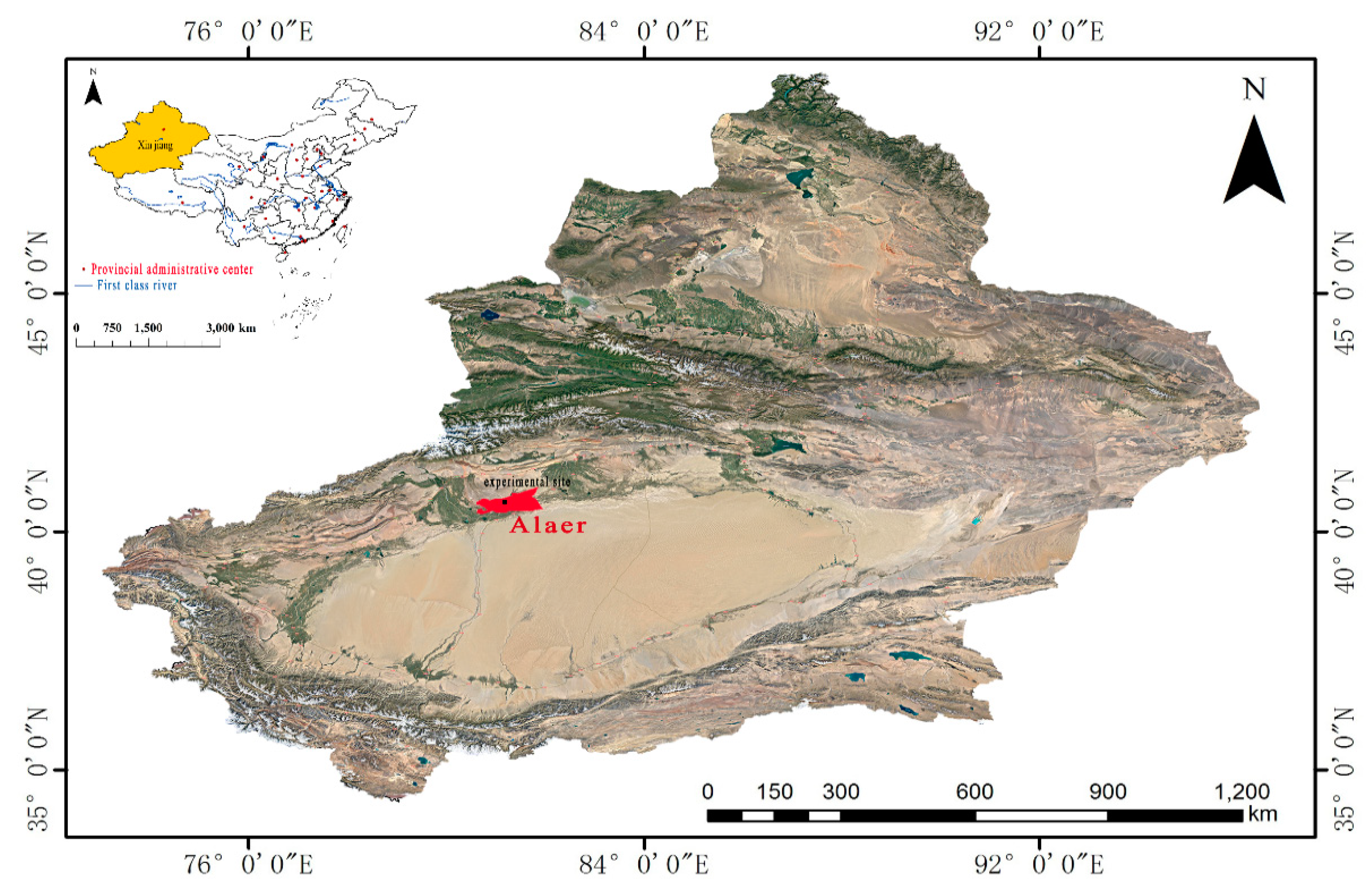
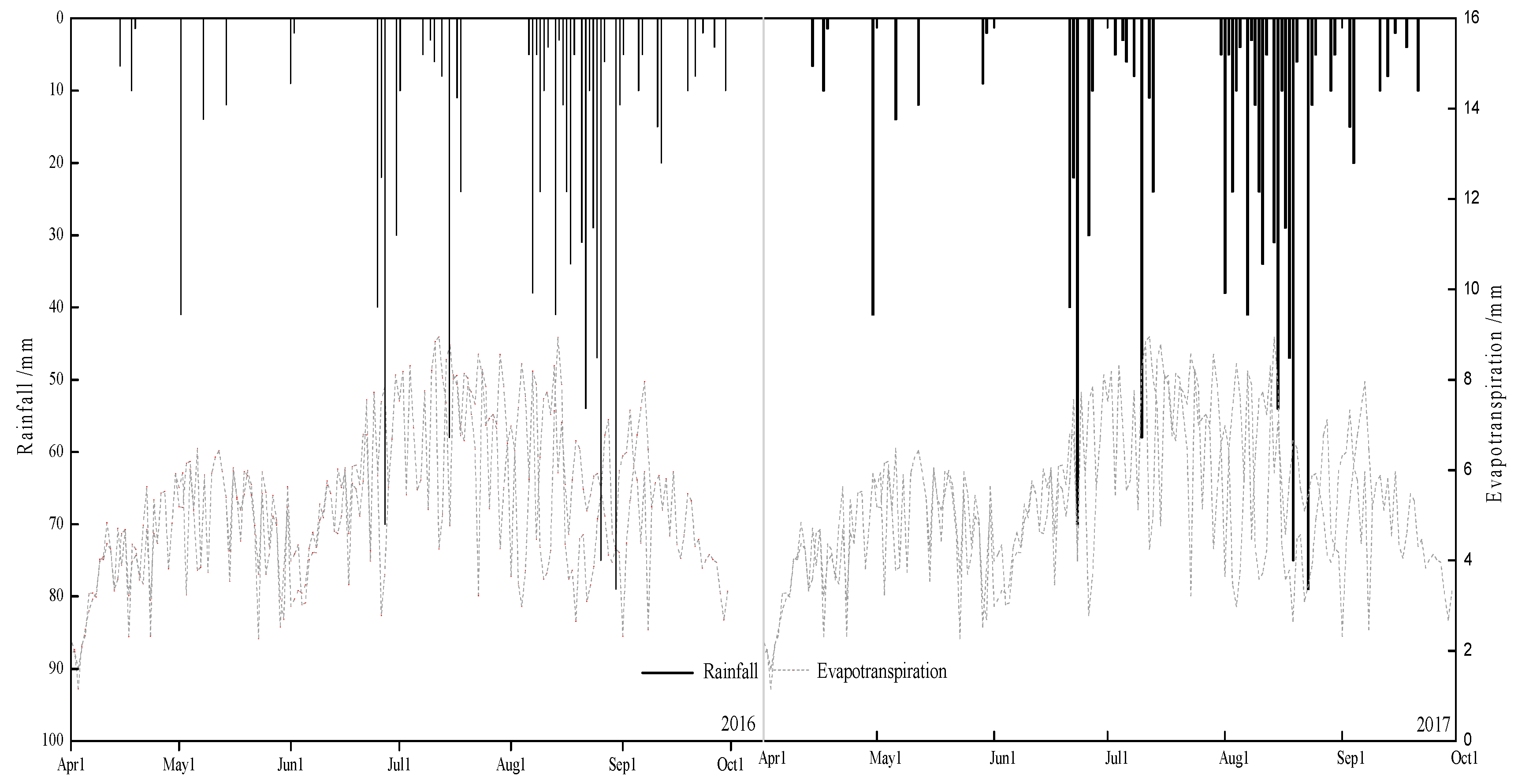
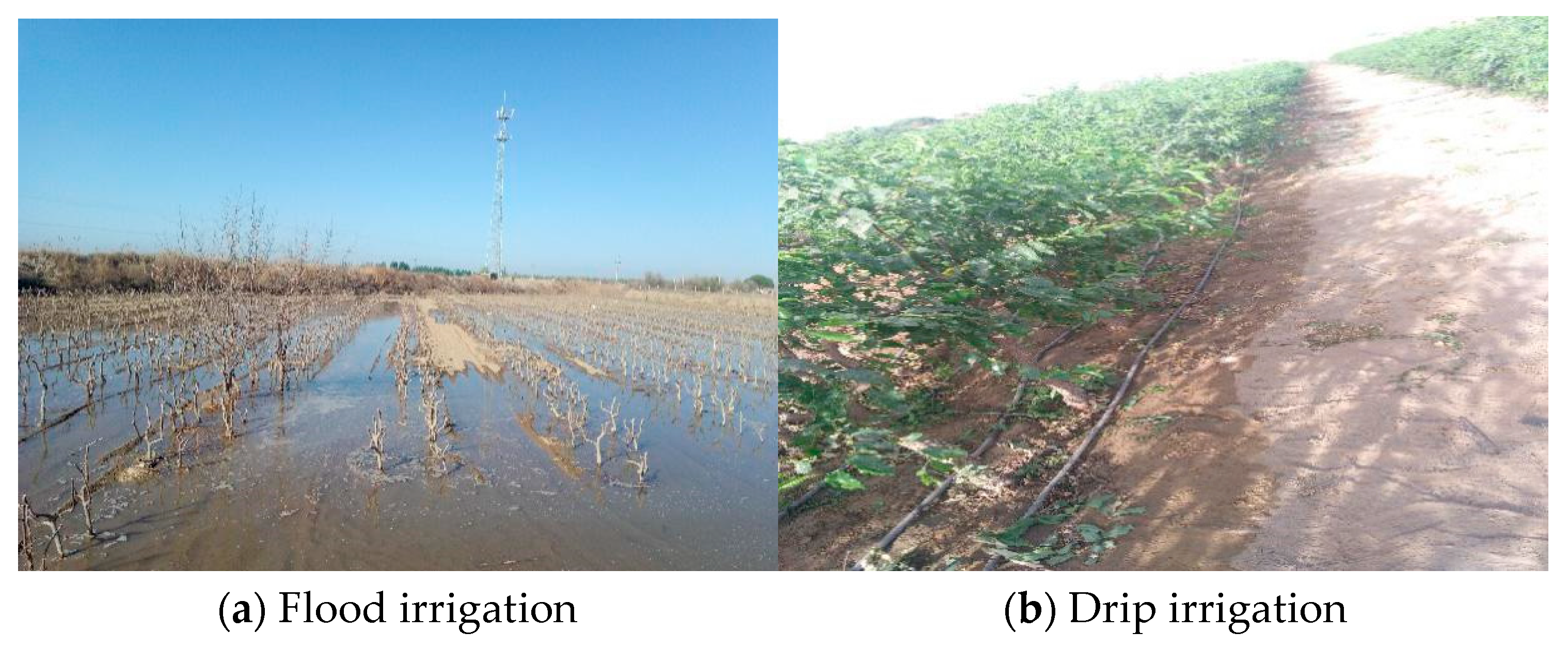

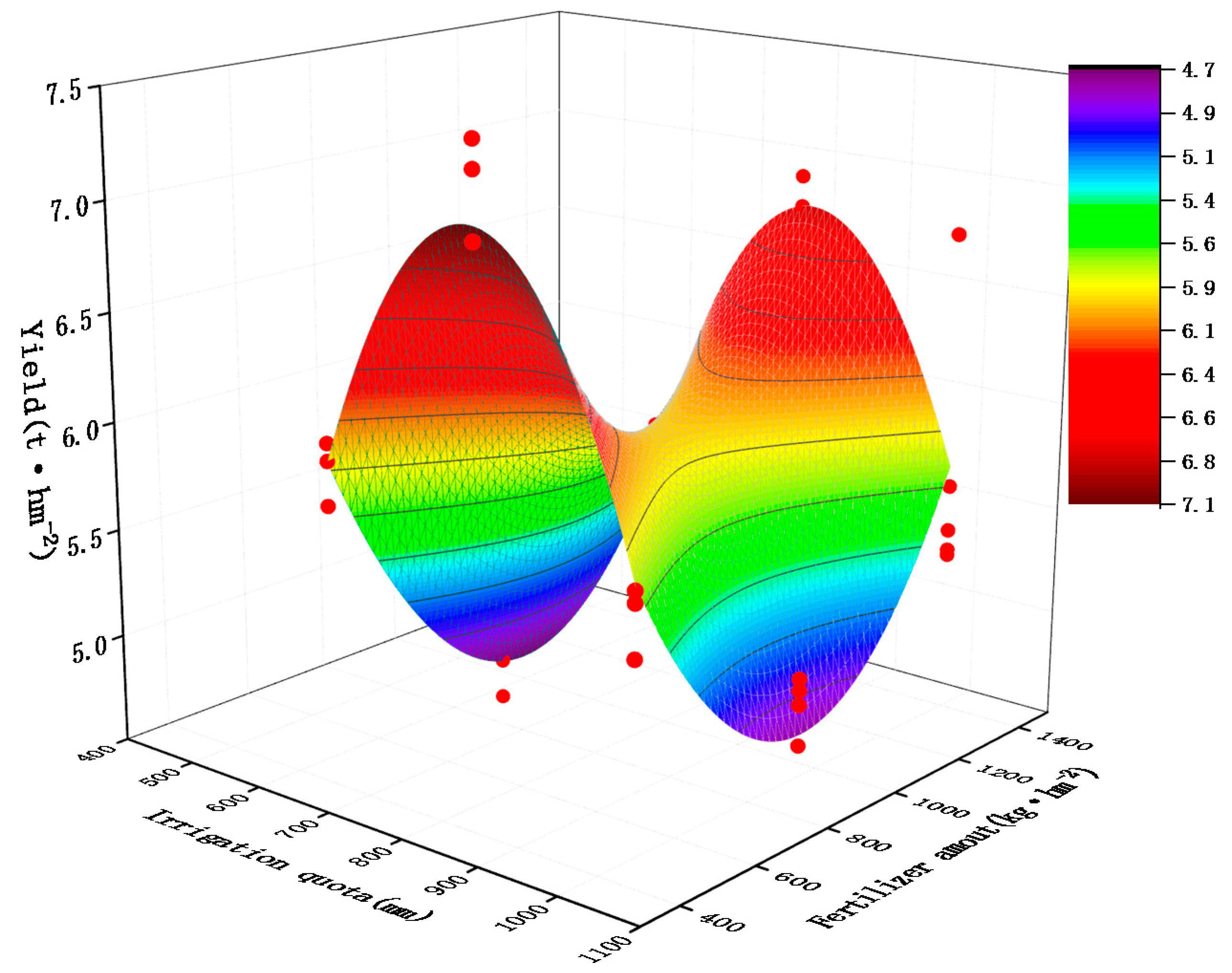
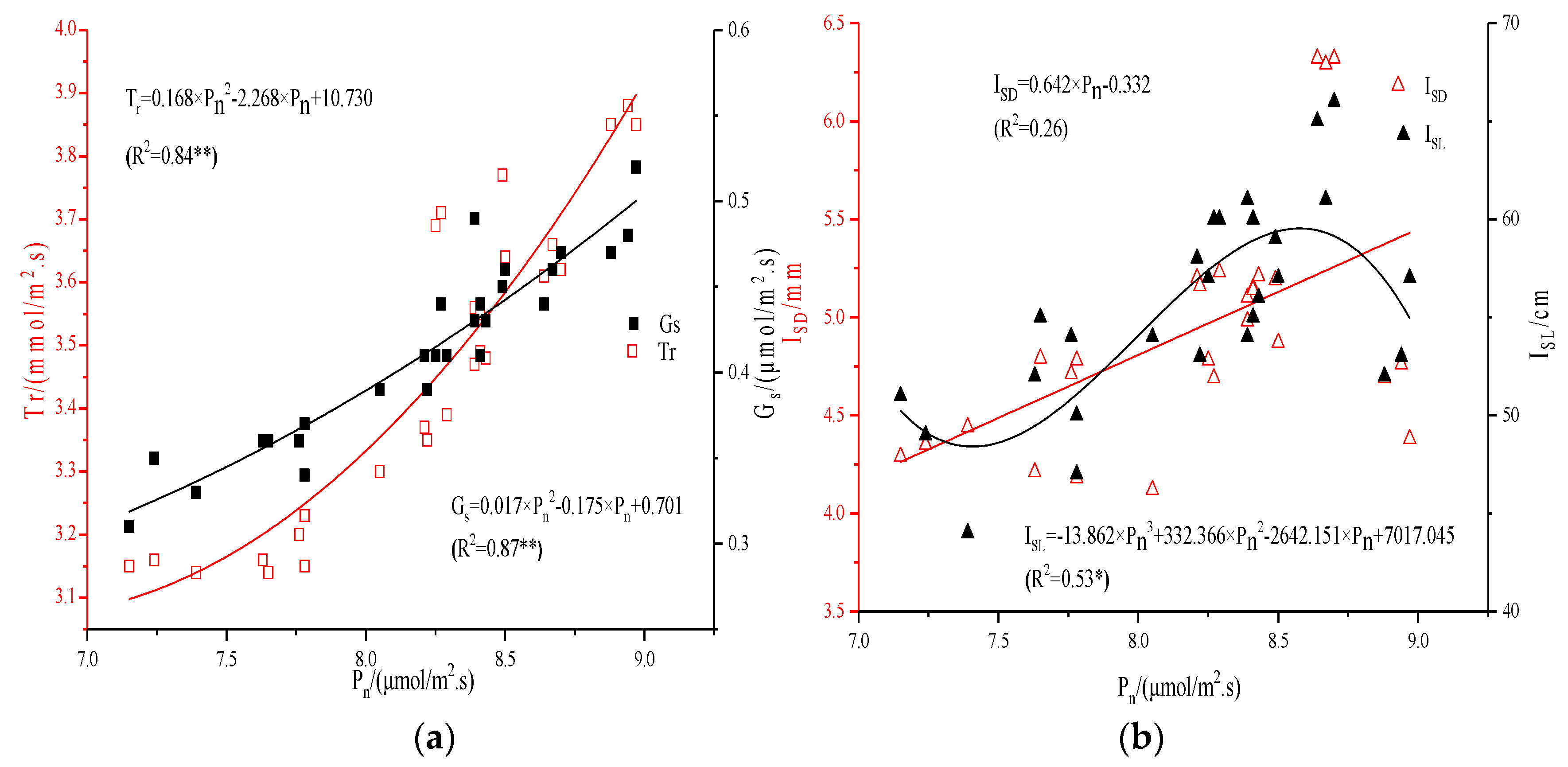

| Soil Layer/cm | Soil Type | Field Moisture Capacity/(g·g−1) | Soil Bulk Density/(g·cm−3) | Soil Density/(g·cm−3) | Soil Total Porosity/% | Capillary Porosity/% |
|---|---|---|---|---|---|---|
| 0–20 | loamy sand soil | 0.19 | 1.51 ± 0.03 | 2.05 ± 0.08 | 47.6 ± 1.35 | 45.28 ± 0.78 |
| 20–40 | sand soil | 0.20 | 1.57 ± 0.03 | 1.89 ± 0.05 | 42.11 ± 1.45 | 40.12 ± 0.98 |
| 40–60 | loamy sand soil | 0.19 | 1.53 ± 0.04 | 1.43 ± 0.06 | 43.27 ± 0.42 | 41.02 ± 0.87 |
| 60–80 | sand soil | 0.20 | 1.58 ± 0.07 | 2.09 ± 0.05 | 41.74 ± 1.05 | 39.24 ± 0.66 |
| Year | Growth Stage | Period | Irrigation Treatment/mm | Fertilization Treatment/kg ha−1 | Flood Irrigation | Irrigation Times | Fertilization Times | |||||
|---|---|---|---|---|---|---|---|---|---|---|---|---|
| W1 | W2 | W3 | F1 | F2 | F3 | W | F | |||||
| 2016 | Budding and shooting | 04/30–06/20 | 70 | 110 | 150 | 90 | 180 | 270 | 150 | 270 | 1 | 1 |
| Flowering | 06/21–07/20 | 160 | 200 | 240 | 120 | 240 | 360 | 240 | 360 | 2 | 2 | |
| Fruiting | 07/21–08/17 | 160 | 200 | 240 | 120 | 240 | 360 | 240 | 360 | 2 | 2 | |
| White maturity | 08/18–09/18 | 160 | 200 | 240 | 120 | 240 | 360 | 240 | 360 | 2 | 2 | |
| Fully maturity | 09/19–10/30 | 70 | 110 | 150 | — | — | — | 150 | — | 1 | 0 | |
| 2017 | Budding and shooting | 05/05–06/15 | 60 | 100 | 140 | 80 | 170 | 260 | 140 | 260 | 1 | 1 |
| Flowering | 06/16–07/15 | 150 | 190 | 230 | 110 | 230 | 350 | 230 | 350 | 2 | 2 | |
| Fruiting | 07/16–08/06 | 150 | 190 | 230 | 110 | 230 | 350 | 230 | 350 | 2 | 2 | |
| White maturity | 08/07–09/16 | 150 | 190 | 230 | 110 | 230 | 350 | 230 | 350 | 2 | 2 | |
| Fully maturity | 09/17–11/05 | 60 | 100 | 140 | — | — | — | 140 | — | 1 | 0 | |
| Years | Treatments | Pn/μmol·m−2·s−1 | Tr/mmol·m−2·s−1 | Gs/μmol·m−2·s−1 | Ci/μmol·m−2·s−1 | CC/mg·g−1 | PNUE/μmol·CO2·g−1 Ns−1 |
|---|---|---|---|---|---|---|---|
| 2016 | W1F1 | 7.26 ± 0.07 f | 3.15 ± 0.06 b | 0.31 ± 0.01 c | 447.50 ± 2.78 f | 49.2 ± 0.85 b | 1.96 ± 0.16 c |
| W1F2 | 7.82 ± 0.12 e | 3.17 ± 0.02 b | 0.33 ± 0.02 c | 519.89 ± 3.38 e | 44.5 ± 1.25 c | 1.96 ± 0.08 c | |
| W1F3 | 7.73 ± 0.04 e | 3.19 ± 0.05 b | 0.35 ± 0.10 c | 365.07 ± 5.11 g | 43.2 ± 0.38 c | 2.15 ± 0.02 b | |
| W2F1 | 8.93 ± 0.03 a | 3.86 ± 0.01 a | 0.49 ± 0.02 a | 707.41 ± 4.48 a | 52.2 ± 0.51 ab | 2.20 ± 0.04 a | |
| W2F2 | 8.34 ± 0.08 cd | 3.68 ± 0.02 a | 0.47 ± 0.04 ab | 639.25 ± 3.45 b | 44.9 ± 0.58 c | 2.25 ± 0.04 a | |
| W2F3 | 8.43 ± 0.03 c | 3.76 ± 0.02 a | 0.45 ± 0.02 b | 710.42 ± 2.79 a | 52.6 ± 1.77 ab | 1.99 ± 0.07 c | |
| W3F1 | 8.24 ± 0.05 d | 3.27 ± 0.06 b | 0.35 ± 0.02 c | 631.01 ± 2.52 b | 51.9 ± 0.58 ab | 2.03 ± 0.02 c | |
| W3F2 | 8.67 ± 0.13 b | 3.40 ± 0.06 b | 0.36 ± 0.02 c | 592.06 ± 2.04 c | 43.8 ± 0.77 c | 2.19 ± 0.03 a | |
| W3F3 | 8.41 ± 0.09 cd | 3.28 ± 0.05 b | 0.44 ± 0.03 b | 536.53 ± 1.44 d | 53.0 ± 0.69 a | 1.97 ± 0.03 c | |
| CK | 7.93 ± 0.15 e | 3.29 ± 0.04 b | 0.45 ± 0.27 b | 639.26 ± 2.56 b | 50.0 ± 0.53 ab | 2.03 ± 0.06 b | |
| 2017 | W1F1 | 7.54 ± 0.05 c | 3.24 ± 0.05 bc | 0.36 ± 0.01 c | 568.48 ± 2.78 d | 44.2 ± 0.74 d | 1.96 ± 0.05 c |
| W1F2 | 7.78 ± 0.09 c | 3.28 ± 0.04 bc | 0.32 ± 0.02 c | 597.89 ± 4.31 c | 46.5 ± 1.17 c | 1.99 ± 0.07 c | |
| W1F3 | 8.05 ± 0.06 bc | 3.09 ± 0.03 c | 0.42 ± 0.10 bc | 604.19 ± 6.48 c | 46.9 ± 0.98 c | 2.06 ± 0.03 b | |
| W2F1 | 8.51 ± 0.04 a | 3.68 ± 0.06 a | 0.48 ± 0.02 a | 678.22 ± 4.48 a | 51.5 ± 0.74 a | 2.19 ± 0.05 a | |
| W2F2 | 8.49 ± 0.07 ab | 3.57 ± 0.07 b | 0.41 ± 0.04 ab | 659.69 ± 3.45 ab | 46.6 ± 0.78 c | 2.14 ± 0.03 ab | |
| W2F3 | 8.36 ± 0.06 cb | 3.49 ± 0.06 b | 0.45 ± 0.02 b | 654.42 ± 6.74 ab | 51.6 ± 1.47 ab | 1.90 ± 0.05 c | |
| W3F1 | 8.41 ± 0.08 b | 3.54 ± 0.06 b | 0.46 ± 0.02 ab | 648.27 ± 3.75 b | 50.9 ± 0.14 b | 2.11 ± 0.04 ab | |
| W3F2 | 8.39 ± 0.08 b | 3.48 ± 0.03 b | 0.45 ± 0.02 b | 652.34 ± 3.48 ab | 44.4 ± 0.87 cd | 2.12 ± 0.06 ab | |
| W3F3 | 8.35 ± 0.10 b | 3.39 ± 0.02 b | 0.44 ± 0.03 b | 649.26 ± 5.10 b | 51.8 ± 0.79 a | 2.06 ± 0.04 b | |
| CK | 8.21 ± 0.09 b | 3.45 ± 0.06 b | 0.45 ± 0.03 b | 635.19 ± 3.07 b | 51.1 ± 0.93 ab | 2.05 ± 0.05 b | |
| Significant Analysis | |||||||
| 2016 | W (irrigation) | 10.35 * | 63.20 ** | 13.90 ** | 13.43 ** | 1.93 | 0.79 |
| F (fertilization) | 0.39 | 0.10 | 0.15 | 0.17 | 0.20 | 0.12 | |
| W × F | 77.55 ** | 10.52 ** | 10.60 ** | 1251.19 * | 10.87 ** | 7.89 ** | |
| 2017 | W (irrigation) | 11.72 * | 54.69 ** | 25.49 ** | 19.48 ** | 0.86 | 0.99 |
| F (fertilization) | 0.45 | 0.69 | 0.75 | 0.48 | 0.22 | 0.24 | |
| W × F | 100.55 ** | 25.44 ** | 16.46 ** | 69.13 * | 14.59 ** | 10.01 ** | |
| Cropping Year | Treatments | ISL/mm | Y/kg ha−1 | iWUE/kg·m−3 | PFP/kg·kg−1 | EI/% |
|---|---|---|---|---|---|---|
| 2016 | W1F1 | 48 ± 2.08 c | 5450 ± 104.58 d | 7.57 ± 0.15 b | 12.11 ± 0.54 b | — |
| W1F2 | 51 ± 2.08 bc | 4661 ± 85.58 e | 6.47 ± 0.12 c | 5.53 ± 0.25 d | −14.48 | |
| W1F3 | 53 ± 1.53 bc | 5879 ± 84.79 c | 8.17 ± 0.25 a | 4.75 ± 0.36 d | 7.87 | |
| W2F1 | 54 ± 2.08 b | 6956 ± 125.79 a | 7.87 ± 0.14 ab | 16.12 ± 0.58 a | 33.14 | |
| W2F2 | 58 ± 1.53 b | 6803 ± 84.89 b | 7.38 ± 0.19 b | 8.06 ± 0.44 c | 24.83 | |
| W2F3 | 56 ± 1.53 b | 5799 ± 55.65 c | 6.29 ± 0.16 c | 4.69 ± 0.35 d | 6.40 | |
| W3F1 | 57 ± 1.53 b | 5603 ± 89.81 cd | 5.19 ± 0.15 d | 12.45 ± 0.66 b | 2.81 | |
| W3F2 | 64 ± 1.00 a | 4894 ± 95.73 e | 4.53 ± 0.14 e | 5.81 ± 0.45 d | −10.20 | |
| W3F3 | 59 ± 1.53 ab | 5414 ± 105.23 d | 5.01 ± 0.21 d | 4.37 ± 0.22 d | −0.66 | |
| CK | 61 ± 1.46 ab | 6796 ± 89.78 b | 6.31 ± 0.12 c | 5.49 ± 0.12 d | 24.70 | |
| 2017 | W1F1 | 49 ± 1.52 c | 5651 ± 97.85 d | 13.89 ± 0.15 b | 13.78 ± 0.54 b | — |
| W1F2 | 51 ± 1.70 c | 5798 ± 106.46 e | 14.25 ± 0.12 c | 6.74 ± 0.25 d | 2.60 | |
| W1F3 | 50 ± 2.03 c | 6047 ± 88.69 c | 14.86 ± 0.25 a | 4.62 ± 0.36 d | 7.01 | |
| W2F1 | 55 ± 1.25 b | 7056 ± 111.45 a | 13.74 ± 0.14 ab | 17.20 ± 0.58 a | 24.86 | |
| W2F2 | 57 ± 1.26 b | 6803 ± 109.48 b | 13.25 ± 0.19 b | 7.91 ± 0.44 c | 20.38 | |
| W2F3 | 56 ± 1.73 b | 6716 ± 78.95 c | 13.07 ± 0.16 c | 5.12 ± 0.35 d | 18.84 | |
| W3F1 | 60 ± 1.26 a | 6841 ± 97.58 cd | 10.57 ± 0.15 d | 16.68 ± 0.66 b | 21.06 | |
| W3F2 | 62 ± 2.00 a | 5984 ± 108.44 e | 9.24 ± 0.14 e | 6.96 ± 0.45 d | 5.89 | |
| W3F3 | 58 ± 1.25 ab | 6144 ± 97.52 d | 9.50 ± 0.21 d | 4.69 ± 0.22 d | 8.72 | |
| CK | 61 ± 2.00 a | 6648 ± 91.42 b | 8.31 ± 0.12 c | 7.38 ± 0.12 d | 24.70 | |
| Significant Analysis | ||||||
| 2016 | W (irrigation) | 8.46 * | 4.71 | 11.32 ** | 0.20 | / |
| F (fertilization) | 0.70 | 0.41 | 0.17 | 29.01 ** | / | |
| W × F | 78.12 ** | 78.01 ** | 155.82 ** | 758.71 ** | / | |
| 2017 | W (irrigation) | 10.11 * | 1.59 | 9.48 * | 0.22 | / |
| F (fertilization) | 0.41 | 0.13 | 0.14 | 18.75 ** | / | |
| W × F | 56.89 ** | 98.46 * | 205.49 ** | 544.17 ** | / | |
© 2018 by the authors. Licensee MDPI, Basel, Switzerland. This article is an open access article distributed under the terms and conditions of the Creative Commons Attribution (CC BY) license (http://creativecommons.org/licenses/by/4.0/).
Share and Cite
Wang, Z.; Bian, Q.; Zhang, J.; Zhou, B. Optimized Water and Fertilizer Management of Mature Jujube in Xinjiang Arid Area Using Drip Irrigation. Water 2018, 10, 1467. https://doi.org/10.3390/w10101467
Wang Z, Bian Q, Zhang J, Zhou B. Optimized Water and Fertilizer Management of Mature Jujube in Xinjiang Arid Area Using Drip Irrigation. Water. 2018; 10(10):1467. https://doi.org/10.3390/w10101467
Chicago/Turabian StyleWang, Zhenhua, Qingyong Bian, Jinzhu Zhang, and Bo Zhou. 2018. "Optimized Water and Fertilizer Management of Mature Jujube in Xinjiang Arid Area Using Drip Irrigation" Water 10, no. 10: 1467. https://doi.org/10.3390/w10101467





